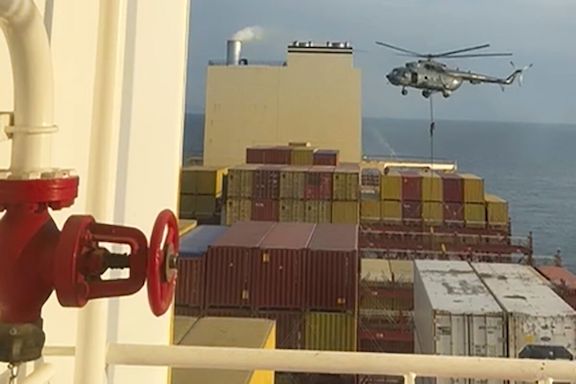The MSC Aries wasn’t much different from the other 7,000 container ships plying the high seas, until it took an involuntary detour near the Strait of Hormuz into the hands of Iran’s Islamic Revolutionary Guard Corps.
Now the floating cog in the world’s industrial economy has become caught up in the tensions wracking the Middle East — and serves as an example of the pain global supply chains will feel if the disruptions worsen.
Complicating the diplomacy to free the vessel are the nationalities of the crew, which include sailors from India and Russia – two key trading partners of Iran. The seizure on Saturday came in the run-up to Tehran’s drone and missile attack on Israel, raising the specter of a wider Mideast conflict that would mean more costly shipping detours around the region’s crucial trade lanes.

“It’s a little unclear right now if there’s going to be a disruption of some time, or is it just this one vessel,” said Kyle Henderson, the CEO of Vizion Inc., a tech company that provides visibility of supply chains. “Has Iran said, ‘we’ve made our point, we’re good for now,’ or — as we saw with other disruptions this year — are ocean carriers going to start avoiding that area for a certain period of time.”
Any more trouble in the Strait of Hormuz will cause the most problems for oil tankers, but 15% of the ships passing through are container vessels frequenting ports such as Jebel Ali in the United Arab Emirates. These play a key role in ensuring supplies flow to global manufacturers.
With the capacity to carry nearly 15,000 20-foot containers, the MSC Aries is about 9,000 shy of the biggest built these days. At 1,200 feet (366 meters) long, it’s still huge — longer than New York’s Chrysler building is tall and as wide as the 12-lane stretch of the New Jersey Turnpike.
While most container manifests aren’t visible during a ship’s journey or made public until bills of lading are processed, Silicon Valley-based Vizion produced data shared with Bloomberg News giving a glimpse into the contents of some of the MSC Aries’ freight, where the goods are headed and the companies affected.
Using information from ocean-freight booking platforms used by carriers, shippers and freight forwarders, a tool called TradeView developed by Vizion and Dun & Bradstreet identified more than 1,000 of the ship’s unknown total payload of containers. The goods in that sample are estimated to be worth $174 million.
While the vessel was carrying lots of mundane items for industrial use such as plastic pellets, also on board are containers that can be more dangerous if not properly handled. More than 50 of them are explicitly classified as dangerous, toxic, or a pollutant.
The final destinations for the goods were spread across nearly 60 countries, involving US importers including Exxon Mobil Corp. and Dow Inc. – and scores more with less-recognizable names in Europe, Canada and South America, according to Vizion.
A spokeswoman for Exxon Mobil couldn’t immediately verify whether any of its freight was aboard the MSC Aries, and Dow media representatives didn’t immediately respond to a request for comment.
Trade Chokepoint
What stands out is the volume of cargo tracked by Vizion that consists of intermediate goods – chemicals, polypropylene used to make plastic, resins, fertilizers, electronic components, fabric and metals — over the smaller amount of finished consumer products.
The MSC Aries was on a loop between India and Sri Lanka, the Middle East and Europe. Much of the container fleet sailing such routes are bypassing the Mideast altogether and going around Africa given Houthi attacks in the Red Sea haven’t let up.
But others that count on Persian Gulf and Red Sea ports as trans-shipment hubs can’t do the same because of the region’s importance for industrial fluids and components.
“The Strait of Hormuz is more than an energy chokepoint — especially for Gulf economies — and the Aries’ cargo is an example of the complexity of supply chains,” said Gerard DiPippo, a senior geo-economics analyst at Bloomberg Economics. “Iran’s seizure of the ship is another reminder of the vulnerability of maritime chokepoints.”
More than 90 containers on the MSC Aries were headed to the US, but America ranked outside the top 10 destinations, according to Vizion. The largest share of the goods was expected in Turkey, Belgium and Italy.
The ship is chartered by closely held MSC Mediterranean Shipping Co. SA, the world’s largest container line, and its owner is an affiliate of UK-based Zodiac Maritime Ltd., which directed questions about the situation to MSC. Zodiac Maritime is part of Israeli businessman Eyal Ofer’s Zodiac Group, according to data compiled by Bloomberg.
On Wednesday, Geneva, Switzerland-based MSC posted a customer advisory saying the 25-member crew is safe and that “discussions with the Iranian authorities are in progress to secure their earliest release.” It also said it will continue “uninterrupted and regular service” along all routes in the region.
The ship’s capture at an unstable crossroads for trade gives industrial importers another reason to understand the routes their goods are taking, insulate their inventories from unexpected shocks and plan their shipments well in advance.
“Shippers are starting to have to think about the freight routes they are booking, and how many vessels they’re going to be changing onto and where those trans-shipments are happening,” Vizion’s Henderson said. “This is a level of complexity that is a new layer for many shippers out there.”











